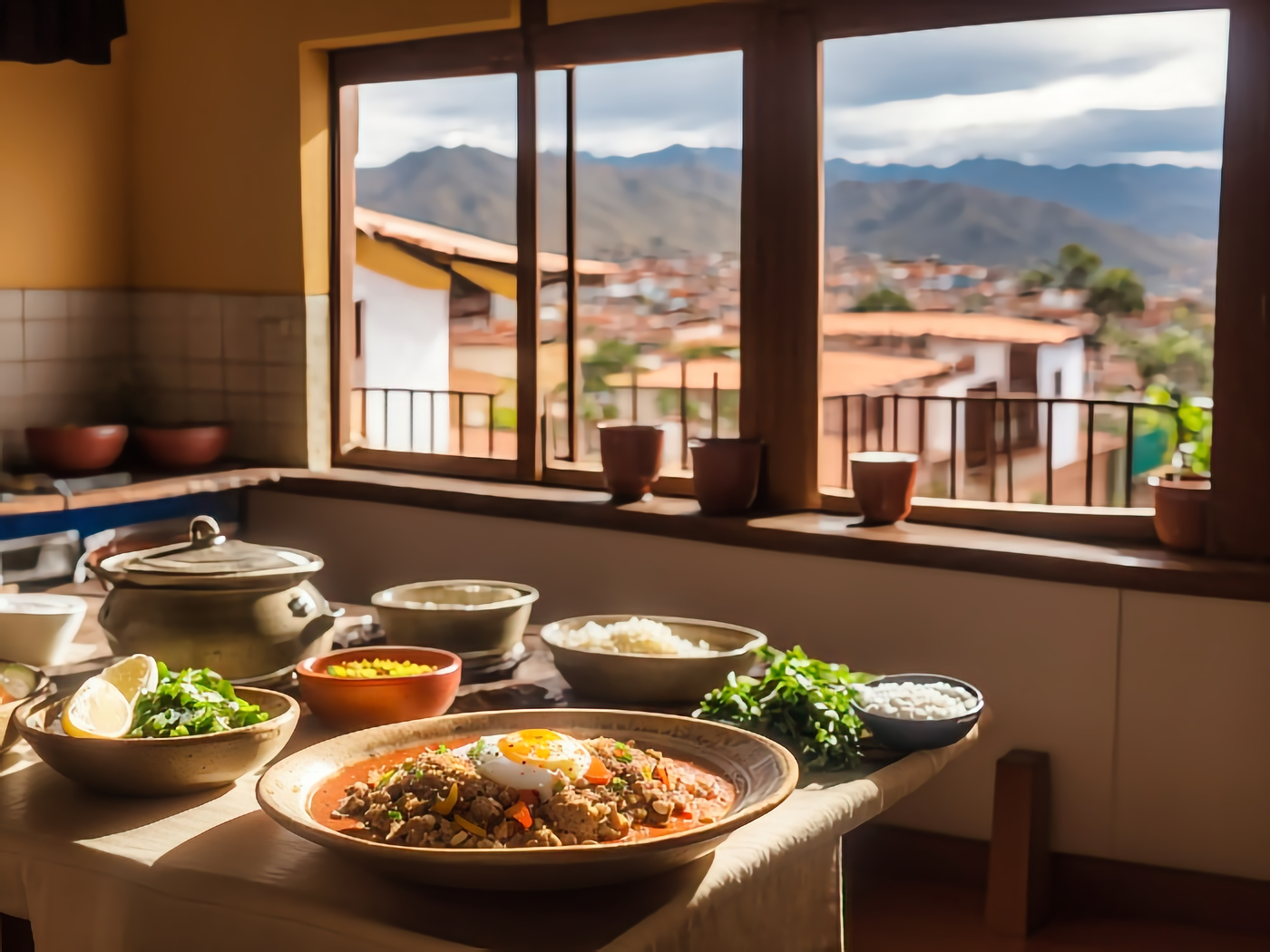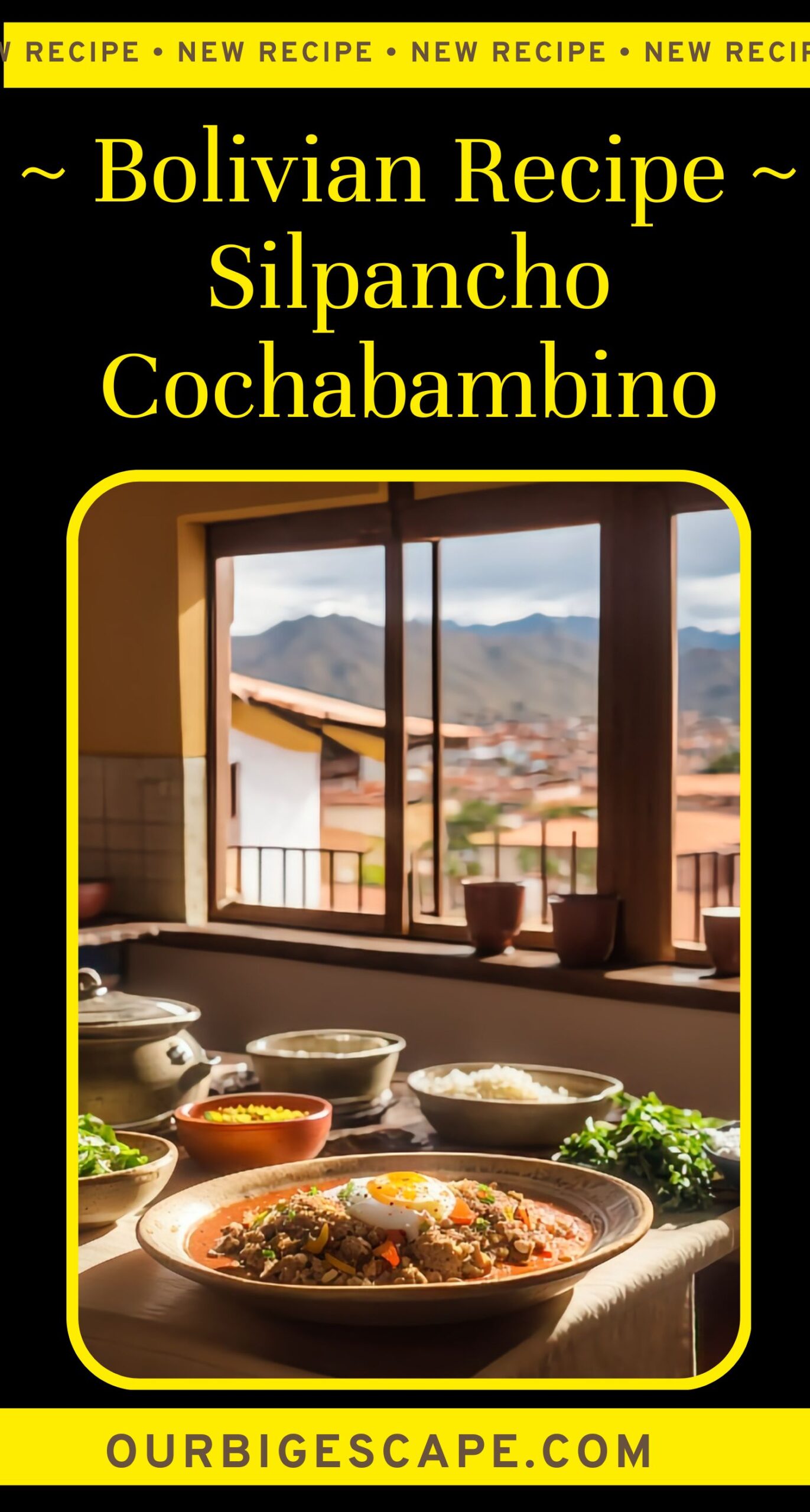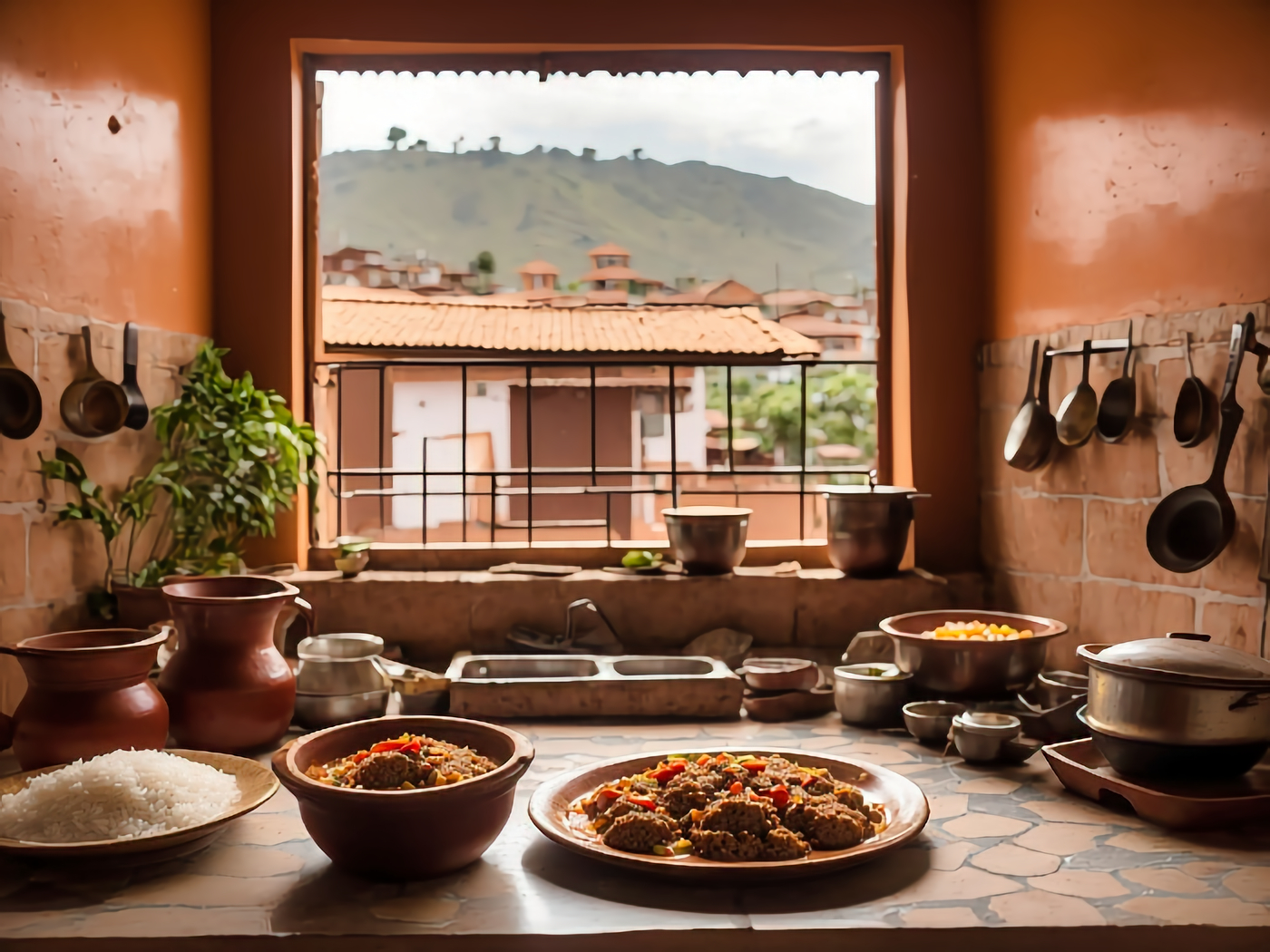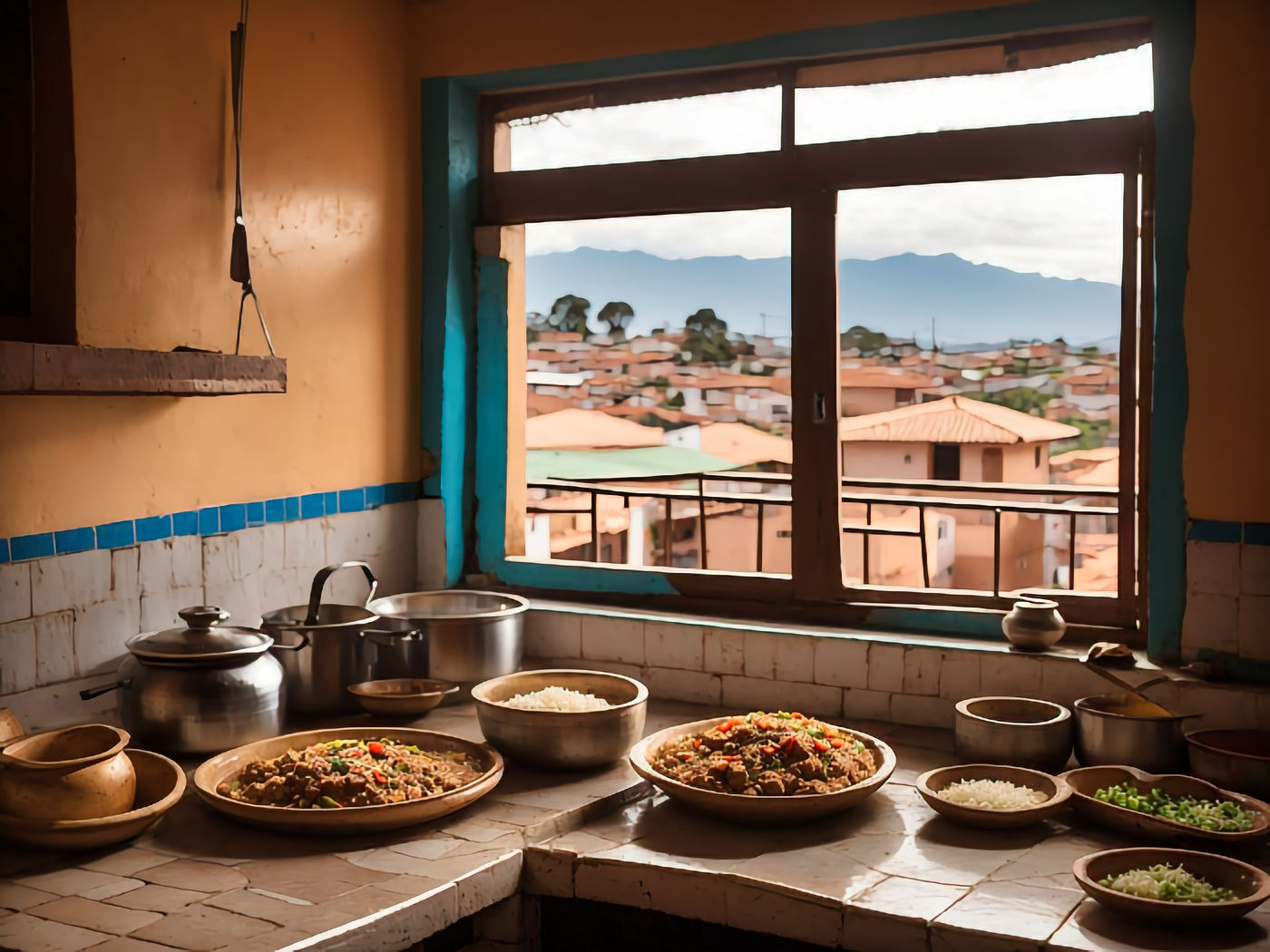
The Bolivian Silpancho Cochabambino Recipe is a traditional dish from Bolivia that is loved for its rich flavors and satisfying taste. This recipe has been passed down through generations and is a popular choice among food enthusiasts.
The Bolivian Silpancho Cochabambino Recipe is known for its simple yet delicious combination of ingredients. It typically includes a base of rice, topped with a thin layer of tender beef or pork cutlets. On top of the meat, you will find a layer of finely chopped tomatoes, onions, and locoto peppers, which add a hint of spiciness to the dish. To complete the Silpancho Cochabambino, it is traditionally served with a fried egg on top.
Want more ideas for Your Recipe Box?
A lot of great options are in these posts!
25 Unbelievable Bolivian Food Traditions & Recipes
One of the great things about the Bolivian Silpancho Cochabambino Recipe is its versatility. While the base ingredients remain the same, you can easily customize it to suit your taste preferences. Some people choose to add additional toppings like avocado slices or a side of salsa, enhancing the flavors even further.
In addition to its delicious taste, the Bolivian Silpancho Cochabambino Recipe offers several potential health benefits. It contains a good balance of protein from the meat, which is essential for muscle growth and repair. The dish also includes vegetables like tomatoes and onions, which provide important vitamins and minerals.
You May Want to Join The World Recipes With Our Big Escape
Share your own recipes in our Facebook Group. Find recipes from all over the world. Learn more about International Cuisine and how you can surprise your family with new and exciting foods from all over the world.
For More Photos Visit Our Instagram at World Recipes Daily
Furthermore, the Bolivian Silpancho Cochabambino Recipe is a filling and satisfying meal, making it a great option for those looking to maintain a healthy weight. The combination of protein, fiber-rich rice, and vegetables helps to keep you feeling full and satisfied for longer periods.
Overall, the Bolivian Silpancho Cochabambino Recipe is a delicious and nutritious dish that showcases the flavors of Bolivia. With its simple ingredients and customizable toppings, it is a versatile choice for any meal. Whether you’re a fan of Bolivian cuisine or looking to try something new, the Silpancho Cochabambino is definitely worth a try!

How To Make Our Bolivian Silpancho Cochabambino Recipe
Ingredients (8 Servings)
8 beef or pork cutlets (about 6 ounces each)
1 1/2 cups of rice
¼ cup Parsley (chopped) ¼ cup
2 tbsp Olive oil 2 tbsp
1 tbsp Apple cider vinegar 1 tbsp
Oil (for frying)
1 cup panko 1 cup
4 large tomatoes, diced
1 medium onions, finely chopped
2-3 locoto peppers (or substitute with jalapeño or serrano peppers), finely chopped
8 eggs
2 tsp garlic powder
½ tsp paprika
1 ½ tsp salt
1 ½ tsp cumin
⅓ tsp black pepper
Instructions
1. Preparing the Meat Cutlets
a. Place the beef or pork cutlets on a clean cutting board.
b. Season both sides of each cutlet with salt, garlic powder, paprika, cumin, and black pepper.
c. In a shallow dish, spread the panko breadcrumbs evenly.
d. Dip each cutlet into the panko, pressing lightly to coat both sides.
e. Set aside the breaded cutlets on a plate.
2. Cooking the Rice
a. Rinse the rice under cold water until the water runs clear.
b. In a medium-sized pot, bring 3 cups of water to a boil.
c. Add the rinsed rice and reduce the heat to low.
d. Cover the pot with a lid and simmer for about 15-20 minutes or until the rice is tender and the water is absorbed.
e. Once cooked, fluff the rice with a fork and set aside.
3. Preparing the Salsa
a. In a mixing bowl, combine the diced tomatoes, finely chopped onions, and finely chopped locoto peppers.
b. Add the chopped parsley, olive oil, apple cider vinegar, and a pinch of salt.
c. Mix well until all the ingredients are evenly combined.
d. Set aside the salsa for later use.
4. Frying the Cutlets
a. Heat oil in a large skillet or frying pan over medium-high heat.
b. Carefully place the breaded cutlets into the hot oil, ensuring not to overcrowd the pan.
c. Fry each cutlet for about 3-4 minutes per side or until golden brown and crispy.
d. Once cooked, transfer the cutlets to a paper towel-lined plate to remove any excess oil.
5. Frying the Eggs
a. In the same skillet or a separate pan, add a bit more oil if needed.
b. Crack the eggs into the pan and cook them sunny-side-up or to your desired level of doneness.
c. Season the eggs with a pinch of salt and black pepper.
6. Assembling the Silpancho Cochabambino
a. Divide the cooked rice into 8 portions and place them on individual plates.
b. On top of the rice, place a fried cutlet.
c. Spoon a generous amount of the prepared salsa over the cutlet.
d. Finally, place a fried egg on top of each serving.
Prep Time: 20 minutes
Cooking Time: 40 minutes

Pots, Pan and Cooking Equipment Needed for the Bolivian Silpancho Cochabambino Recipe
Skillet or frying pan: for frying the cutlets and eggs
Medium-sized pot: for cooking the rice
Cutting board: for preparing the meat cutlets
Shallow dish: for coating the cutlets with breadcrumbs
Mixing bowl: for combining ingredients for the salsa
Best Way to Store Leftovers From the the Bolivian Silpancho Cochabambino Recipe
a. Transfer any leftover Silpancho Cochabambino to an airtight container.
b. Place the container in the refrigerator to keep the dish fresh.
c. Ensure that the leftovers are cooled down to room temperature before refrigerating.
d. Consume the leftovers within 2-3 days for the best taste and quality.
e. When reheating, warm the leftovers in a skillet or microwave until heated through.
Tips and Tricks For Easier Creation
Prepare all the ingredients beforehand to streamline the cooking process.
Use a meat mallet to flatten the beef or pork cutlets for even cooking.
Coat the cutlets in the breadcrumbs right before frying to maintain crispiness.
Use a non-stick skillet or add a bit of oil to prevent sticking during frying.
Adjust the spiciness of the salsa by adding more or fewer locoto peppers.
Customize the dish by adding additional toppings such as avocado slices or a squeeze of lime.
Serve the Silpancho Cochabambino with a side of Bolivian-style salsa or hot sauce for added flavor.
Side Dishes and Desserts For the the Bolivian Silpancho Cochabambino Recipe
a. Chuño salad: A traditional Bolivian potato salad with onions, tomatoes, and herbs.
b. Ensalada criolla: A refreshing tomato and onion salad dressed with lime juice and herbs.
c. Sliced avocado: Serve fresh avocado slices for a creamy and nutritious addition.
d. Grilled vegetables: Lightly seasoned grilled vegetables such as bell peppers and zucchini complement the dish.
How To Serve the Bolivian Silpancho Cochabambino Recipe
a. Place a portion of cooked rice on each plate as the base.
b. Carefully place a fried cutlet on top of the rice.
c. Spoon a generous amount of the salsa mixture over the cutlet.
d. Add a fried egg on the side or directly on top of the cutlet.
e. Garnish with additional chopped parsley if desired.
f. Serve the Silpancho Cochabambino hot and enjoy!
Dietary Substitution For the Bolivian Silpancho Cochabambino Recipe
1. Vegan Options:
a. Substitute beef or pork cutlets with plant-based cutlets made from ingredients like soy, seitan, or mushrooms.
b. Replace eggs with scrambled tofu or chickpea flour batter for coating.
c. Use vegetable oil instead of olive oil in the Bolivian Silpancho Cochabambino Recipe.
d. Swap regular panko breadcrumbs with a vegan alternative.
e. Choose a vegan-friendly protein source such as tempeh or tofu.
f. Omit eggs and use a vegan mayo-based sauce instead.
g. Ensure all ingredients are free from animal products, such as checking for animal-derived additives in the vinegar or seasonings.
2. Gluten-Free Options: For the Bolivian Silpancho Cochabambino Recipe
a. Use gluten-free bread crumbs or crushed gluten-free cereal as a substitute for panko.
b. Replace regular soy sauce with tamari or gluten-free soy sauce.
c. Choose a gluten-free alternative for the flour used in breading the cutlets.
d. Confirm that all ingredients, including spices and condiments, are certified gluten-free.
e. Use gluten-free vinegar or substitute with lemon or lime juice.
f. Ensure the brand of all packaged ingredients is certified gluten-free.
g. Check for cross-contamination when purchasing pre-cut or pre-packaged ingredients.
3. Vegetarian Options:
a. Use vegetarian-friendly protein alternatives like tofu, tempeh, or seitan instead of meat cutlets.
b. Skip the eggs or use an egg substitute for breading the cutlets.
c. Choose vegetable-based oil for frying the the Bolivian Silpancho Cochabambino Recipe.
d. Opt for vegetable broth or water instead of meat-based broths in the rice.
e. Include additional vegetables such as bell peppers, zucchini, or carrots in the salsa.
f. Add vegetarian-friendly seasonings like nutritional yeast or smoked paprika for extra flavor.
g. Confirm that any pre-packaged or processed ingredients are suitable for vegetarians.
4. Mediterranean Diet Options: For the Bolivian Silpancho Cochabambino Recipe
a. Use lean cuts of beef or pork for the cutlets.
b. Replace regular rice with whole grain or brown rice for added fiber.
c. Add more fresh herbs like basil or oregano to the salsa.
d. Use extra virgin olive oil for frying and in the salsa.
e. Include a side of Greek salad with cucumbers, tomatoes, and feta cheese.
f. Serve with a side of steamed vegetables or grilled eggplant.
g. Use garlic-infused olive oil or fresh minced garlic for an extra Mediterranean touch.
5. Keto Diet Options:
a. Choose fattier cuts of beef or pork for the cutlets.
b. Replace rice with cauliflower rice or shirataki rice as a low-carb alternative.
c. Use almond flour or crushed pork rinds instead of panko for breading.
d. Increase the amount of olive oil or add additional healthy fats like avocado or coconut oil.
e. Adjust the amount of onions and tomatoes to fit within keto macros.
f. Serve with a side of sautéed leafy greens or roasted Brussels sprouts for the Bolivian Silpancho Cochabambino Recipe.
g. Ensure all ingredients, such as spices and seasonings, are low-carb and keto-friendly.
6. Heart Healthy Diet Options: For the Bolivian Silpancho Cochabambino Recipe
a. Choose lean cuts of beef or pork and trim any visible fat.
b. Use brown rice or quinoa instead of white rice for added fiber.
c. Incorporate heart-healthy fats like avocado oil or walnut oil.
d. Limit the amount of added salt and use herbs and spices for flavoring.
e. Include extra vegetables in the salsa for added nutrients.
f. Serve with a side of steamed broccoli or grilled asparagus.
g. Opt for low-sodium soy sauce or tamari in moderation.
7. Paleo Options:
a. Use grass-fed beef or pasture-raised pork for the cutlets.
b. Substitute rice with cauliflower rice or diced roasted sweet potatoes.
c. Use almond flour or crushed nuts as a paleo-friendly alternative to panko.
d. Choose a paleo-approved vinegar like apple cider vinegar in the Bolivian Silpancho Cochabambino Recipe.
e. Include additional paleo-friendly vegetables like bell peppers or kale in the salsa.
f. Serve with a side of roasted root vegetables or a mixed green salad.
g. Use paleo-friendly seasonings like garlic powder, paprika, and cumin.
8. Low Carb Options: For the Bolivian Silpancho Cochabambino Recipe
a. Choose lean cuts of beef or pork for the cutlets.
b. Replace rice with cauliflower rice or spiralized zucchini noodles.
c. Use almond flour or crushed pork rinds instead of panko for breading.
d. Increase the amount of low-carb vegetables like tomatoes and onions in the salsa.
e. Include a side of steamed broccoli or sautéed green beans.
f. Serve with a refreshing cucumber and tomato salad.
g. Opt for low-sugar condiments and sauces in moderation.
9. Whole 30 Options:
a. Use compliant cuts of beef or pork for the cutlets.
b. Substitute rice with cauliflower rice or roasted butternut squash cubes.
c. Use almond flour or crushed nuts as a Whole30-approved alternative to panko.
d. Choose a vinegar without added sugars or preservatives preparing the Bolivian Silpancho Cochabambino Recipe.
e. Include additional Whole30-approved vegetables like bell peppers or asparagus in the salsa.
f. Serve with a side of steamed green beans or roasted Brussels sprouts.
g. Check all seasonings and condiments for compliant ingredients.
10. Weight Watchers Options: For the Bolivian Silpancho Cochabambino Recipe
a. Choose lean cuts of beef or pork and trim visible fat.
b. Adjust the portion sizes of rice and other higher point ingredients to fit within your points budget.
c. Use cooking spray or a minimal amount of oil for frying.
d. Increase the amount of vegetables in the salsa for added volume.
e. Consider using egg whites or an egg substitute to lower the point value.
f. Serve with a side of steamed or roasted vegetables.
g. Be mindful of portion sizes and track points accordingly.
11. Low Fat Options:
a. Choose lean cuts of beef or pork for the cutlets and trim any visible fat.
b. Use cooking spray or a non-stick pan for frying instead of oil.
c. Substitute rice with steamed or boiled cauliflower as a low-fat alternative.
d. Omit or reduce the amount of oil used in the salsa for the Bolivian Silpancho Cochabambino Recipe.
e. Use egg whites or an egg substitute for breading the cutlets.
f. Serve with a side of steamed vegetables or a mixed green salad.
g. Opt for low-fat condiments and sauces in moderation.
12. Vegetable Variations: For the Bolivian Silpancho Cochabambino Recipe
a. Substitute beef or pork cutlets with grilled or roasted portobello mushrooms.
b. Replace rice with quinoa or a mix of cooked grains like farro and barley.
c. Include additional fresh herbs like cilantro or mint in the salsa.
d. Use avocado oil or sesame oil for added flavor in the salsa.
e. Add a variety of colorful vegetables like bell peppers, corn, or diced cucumber to the salsa.
f. Serve with a side of roasted or steamed mixed vegetables.
g. Experiment with different vegetable toppings like roasted beets or sautéed spinach.

FAQ About the Bolivian Silpancho Cochabambino Recipe
How do I make the Bolivian Silpancho Cochabambino Recipe?
To make the Bolivian Silpancho Cochabambino Recipe, you start by preparing the meat cutlets and coating them with breadcrumbs. Then, cook the rice separately. While the rice is cooking, prepare the salsa by combining tomatoes, onions, and locoto peppers. Once everything is ready, fry the cutlets, cook the eggs, and assemble the dish by placing a cutlet on top of a portion of rice and topping it with salsa and a fried egg.
What are the main ingredients in the Bolivian Silpancho Cochabambino Recipe?
The main ingredients in the Bolivian Silpancho Cochabambino Recipe include beef or pork cutlets, rice, tomatoes, onions, locoto peppers (or substitute peppers), eggs, panko breadcrumbs, garlic powder, paprika, salt, cumin, and black pepper. These ingredients come together to create the flavorful layers of the dish.
Can I make substitutions in the Bolivian Silpancho Cochabambino Recipe?
Yes, there are various substitutions you can make in the Bolivian Silpancho Cochabambino Recipe to suit your dietary preferences or requirements. For example, you can use plant-based cutlets for a vegan version, replace rice with cauliflower rice for a low-carb option, or choose lean cuts of meat for a heart-healthy variation. Feel free to explore different options based on your specific needs.
How long does it take to prepare the Bolivian Silpancho Cochabambino Recipe?
The estimated prep time for the Bolivian Silpancho Cochabambino Recipe is around 20 minutes. This includes preparing the ingredients, breading the cutlets, and making the salsa. The estimated cooking time is approximately 40 minutes, which accounts for frying the cutlets, cooking the eggs, and assembling the final dish.
Are there any side dishes that pair well with the Bolivian Silpancho Cochabambino Recipe?
Yes, there are several side dishes that complement the Bolivian Silpancho Cochabambino Recipe. Some options include chuño salad, a traditional Bolivian potato salad, ensalada criolla, a tomato and onion salad, sliced avocado, grilled vegetables, and more. These side dishes add variety and additional flavors to the meal.
Final Thoughts
The Bolivian Silpancho Cochabambino Recipe is a delicious dish that combines tender beef or pork cutlets, flavorful rice, and a vibrant salsa made with tomatoes, onions, and locoto peppers. The dish is further enhanced with a fried egg on top, adding richness and texture.
One of the notable characteristics of the Bolivian Silpancho Cochabambino Recipe is its versatility. While the base ingredients remain the same, you can easily customize the dish by adding additional toppings such as avocado slices or a side of salsa, according to your taste preferences.
In terms of flavors, the Bolivian Silpancho Cochabambino Recipe offers a delightful combination of savory, tangy, and slightly spicy elements. The meat cutlets are seasoned with garlic powder, paprika, salt, cumin, and black pepper, which infuse them with a delicious taste. The salsa, with its diced tomatoes, onions, and locoto peppers, adds a fresh and zesty component to the dish.
Besides its mouthwatering flavors, the Bolivian Silpancho Cochabambino Recipe also offers potential health benefits. It provides a good balance of protein from the meat, essential for muscle growth and repair. The inclusion of vegetables like tomatoes and onions adds valuable vitamins and minerals to the dish. Additionally, the combination of protein, fiber-rich rice, and vegetables helps to keep you feeling full and satisfied.
The Bolivian Silpancho Cochabambino Recipe is a versatile, flavorful, and nutritious dish that showcases the vibrant flavors of Bolivian cuisine. Whether you’re a fan of international flavors or looking to explore new culinary experiences, the Silpancho Cochabambino is a must-try recipe that can be enjoyed by the whole family.
Bolivian Silpancho Cochabambino Recipe
Equipment
- Skillet or frying pan: for frying the cutlets and eggs
- Medium-sized pot: for cooking the rice
- Cutting board: for preparing the meat cutlets
- Shallow dish: for coating the cutlets with breadcrumbs
- Mixing bowl: for combining ingredients for the salsa
- Best Way to Store Leftovers From the the Bolivian Silpancho Cochabambino Recipe
Ingredients
- 8 pork cutlets about 6 ounces each (can use beef cutlets)
- 1 1/2 cups rice
- ¼ cup Parsley chopped ¼ cup
- 2 tbsp Olive oil
- 1 tbsp Apple cider vinegar Apple cider
- vegetable Oil for frying
- 1 cup panko
- 4 tomatoes diced - large
- 1 onions finely chopped - medium
- 2-3 locoto peppers or substitute with jalapeño or serrano peppers, finely chopped
- 8 eggs
- 2 tsp garlic powder
- ½ tsp paprika
- 1 ½ tsp salt
- 1 ½ tsp cumin
- ⅓ tsp black pepper
Instructions
Preparing the Meat Cutlets
- a. Place the beef or pork cutlets on a clean cutting board.
- b. Season both sides of each cutlet with salt, garlic powder, paprika, cumin, and black pepper.
- c. In a shallow dish, spread the panko breadcrumbs evenly.
- d. Dip each cutlet into the panko, pressing lightly to coat both sides.
- e. Set aside the breaded cutlets on a plate.
Cooking the Rice
- a. Rinse the rice under cold water until the water runs clear.
- b. In a medium-sized pot, bring 3 cups of water to a boil.
- c. Add the rinsed rice and reduce the heat to low.
- d. Cover the pot with a lid and simmer for about 15-20 minutes or until the rice is tender and the water is absorbed.
- e. Once cooked, fluff the rice with a fork and set aside.
Preparing the Salsa
- a. In a mixing bowl, combine the diced tomatoes, finely chopped onions, and finely chopped locoto peppers.
- b. Add the chopped parsley, olive oil, apple cider vinegar, and a pinch of salt.
- c. Mix well until all the ingredients are evenly combined.
- d. Set aside the salsa for later use.
Frying the Cutlets
- a. Heat oil in a large skillet or frying pan over medium-high heat.
- b. Carefully place the breaded cutlets into the hot oil, ensuring not to overcrowd the pan.
- c. Fry each cutlet for about 3-4 minutes per side or until golden brown and crispy.
- d. Once cooked, transfer the cutlets to a paper towel-lined plate to remove any excess oil.
Frying the Eggs
- a. In the same skillet or a separate pan, add a bit more oil if needed.
- b. Crack the eggs into the pan and cook them sunny-side-up or to your desired level of doneness.
- c. Season the eggs with a pinch of salt and black pepper.
Assembling the Silpancho Cochabambino
- a. Divide the cooked rice into 8 portions and place them on individual plates.
- b. On top of the rice, place a fried cutlet.
- c. Spoon a generous amount of the prepared salsa over the cutlet.
- d. Finally, place a fried egg on top of each serving.

